Location: Ditcheat to Wraxall, Shepton Mallet
Project Type: Trenchless Technology
Client: Bristol Water
Project Duration: 3 months
Contract Value: £600k
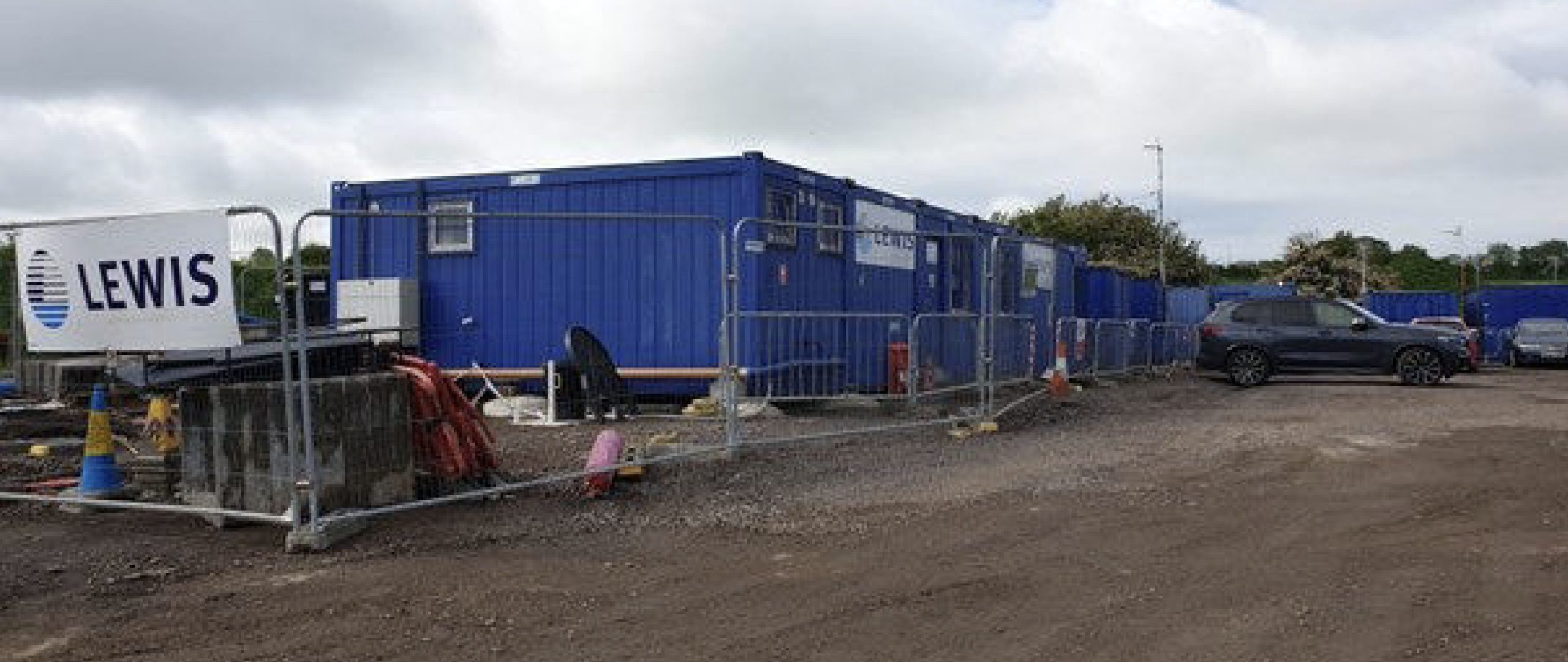
Recent bursts in the Wraxall/Ditcheat area have led to supply disruption, poor water quality, together with causing
disruption to traffic links in the area. The existing water main feeds Ditcheat and all properties/businesses between Ditcheat and Wraxall. Failure of this main has also had a detrimental affect upon Ditcheat Primary School, the Paul Nicholls Racing Stable, Barbers Cheesemakers and The Manor Inn, all of which are heavily dependant on a reliable water supply.
The number of water main bursts in recent years has been significant and required action, resulting in the Wraxall Road scheme which covered the replacement of approximately 2500m of existing 3”CI water main with new 90mm PE.
Due to restrictions placed on the Road Space by Highways, the scheme has been spilt into 2 phases. The first phase covers the slip lining of Ditcheat Hill with 63mm PE and the bursting of the main along Wraxall road through Ditcheat village. The second phase covers the remaining section in Wraxall Road, to be installed by pipe bursting and open cut.
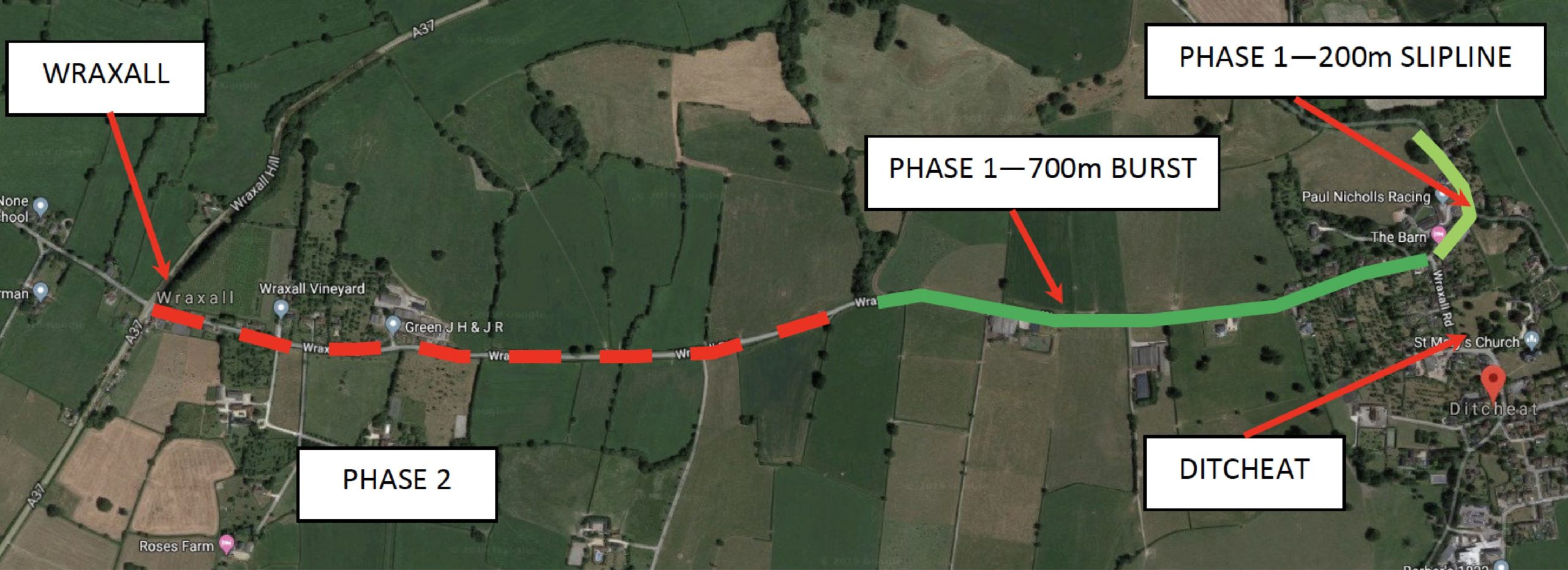
Site— The site is predominantly in the Highway, Wraxall Road, between Wraxall and Ditcheat.
Access—Road closures for sliplining on Ditcheat Hill. Bursting works on Wraxall Road carried out under 2 way lights.
Ground conditions— Predominantly Clay
Pipe– Records show existing 3” CI main, to be replaced with 90mm PE. Asbestos mains in the area, work to stop if encountered.
Services– HP and MP gas main crossings. Also HV / LV power and BT.
Bi-weekly site progress meetings were held with the client, with excellent comments received from both the BW Project Management Team and Operations. Continually beyond expectation in terms of safety visits. Bristol Water have also received customer compliments regarding the conduct of the team onsite.
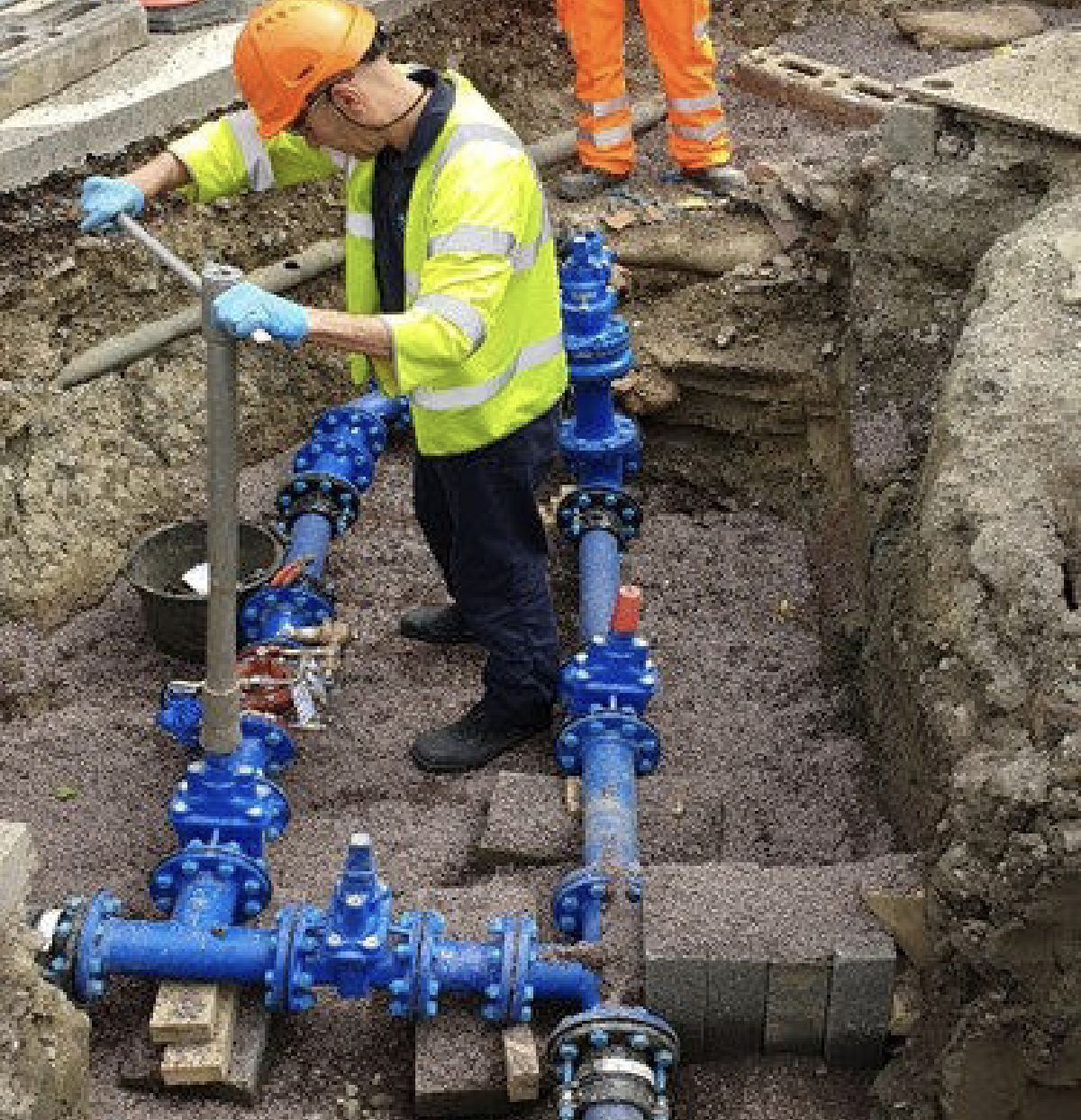
– Lewis Civil Engineering were engaged during Outline design through ECI. Joint site walkovers were undertaken with the PM and Design Team where Trial Holes were identified and potential renovation techniques put forward. 10No trial holes were carried out to confirm methodology and route of new water main. This approach proved very successful and the scheme was constructed with very little change to the agreed Design, ensuring our client was not surprised by additional costs for unforeseen works or changes to installation methods.
– Valves were cut into the existing network during mobilisation under planned short shuts.
– It was identified during ECI that the water network could be rezoned with little work to provide 2 way feed along the Wraxall Road water main. This, along with cutting in valves in advance substantially reduced the requirements for overland pipework and the associated cost.
– Aquam Overland Support Vehicle trialled to see if it offers cost savings over setting up traditional overland pipework system.
– Safety: No accidents or incidents. Site Safety Visits have all been above expectation.
– Cost: Phase 1 completed on budget. No CE’s or EW’s raised, proof of a well-aligned Project delivery team.
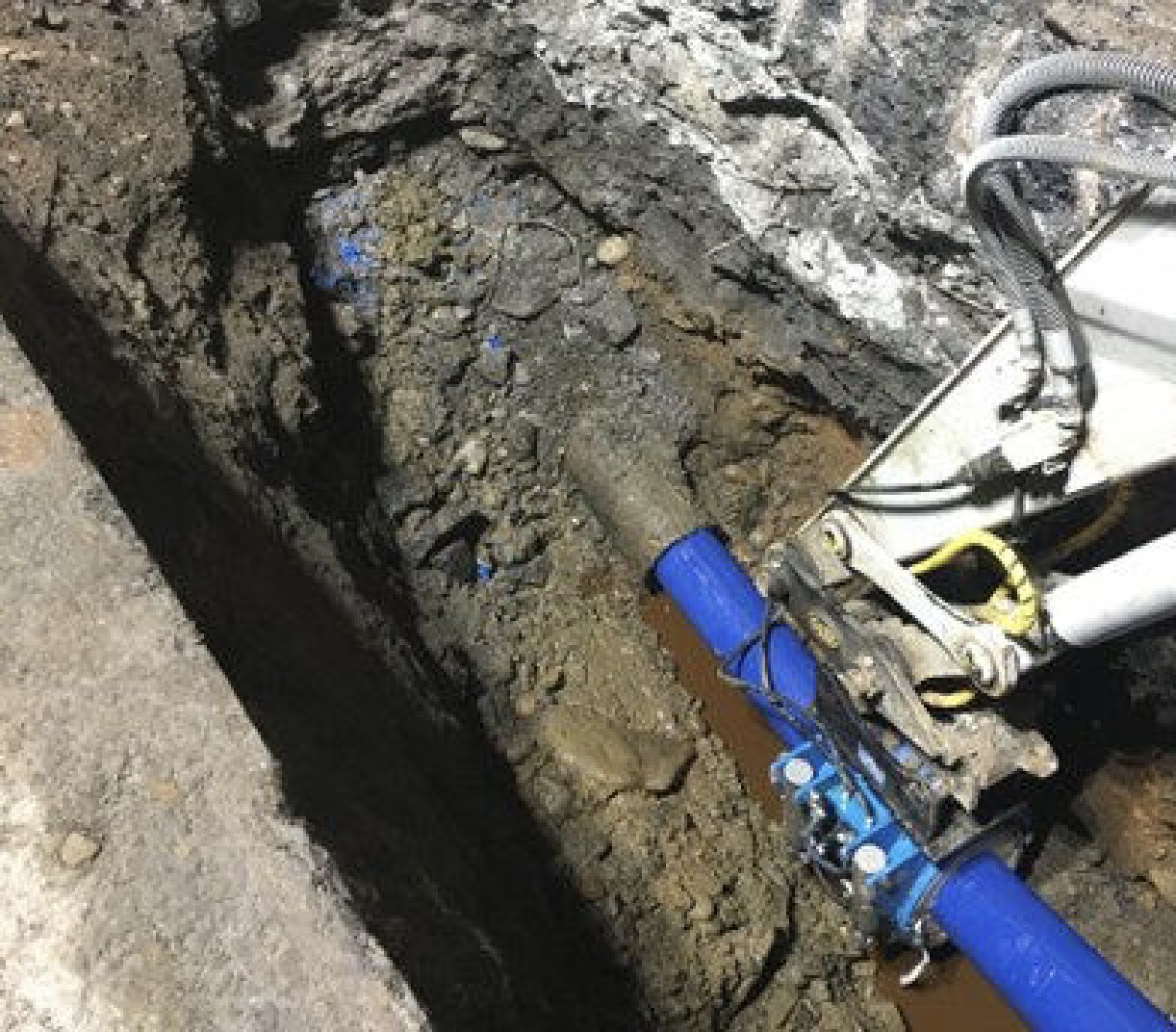
The scheme was constructed in close proximity to many existing services:
– Water: No unplanned shuts, shuts kept to a minimum and affecting as few properties as possible, no shuts in excess of 3 hours. Overland rider systems installed to keep customer supplies live during pipebursting and sliplining. Special focus on high dependency individuals and businesses (for example farms who might require water a differing times of the day)
– HP & MP Gas mains: trial holes carried out to determine the exact route of both HP and MP gas mains. HP gas crossing carried out under Wales and West watching brief
– Other services: service drawings scrutinised and services traced and marked on the ground using CAT and Genny. Hand dig only within 500mm of a service. No services hit during works.
– Horses: works paused to ensure no loud noises
– Pipe & fittings: kept clean in stores and off the ground to ensure no contamination risk.
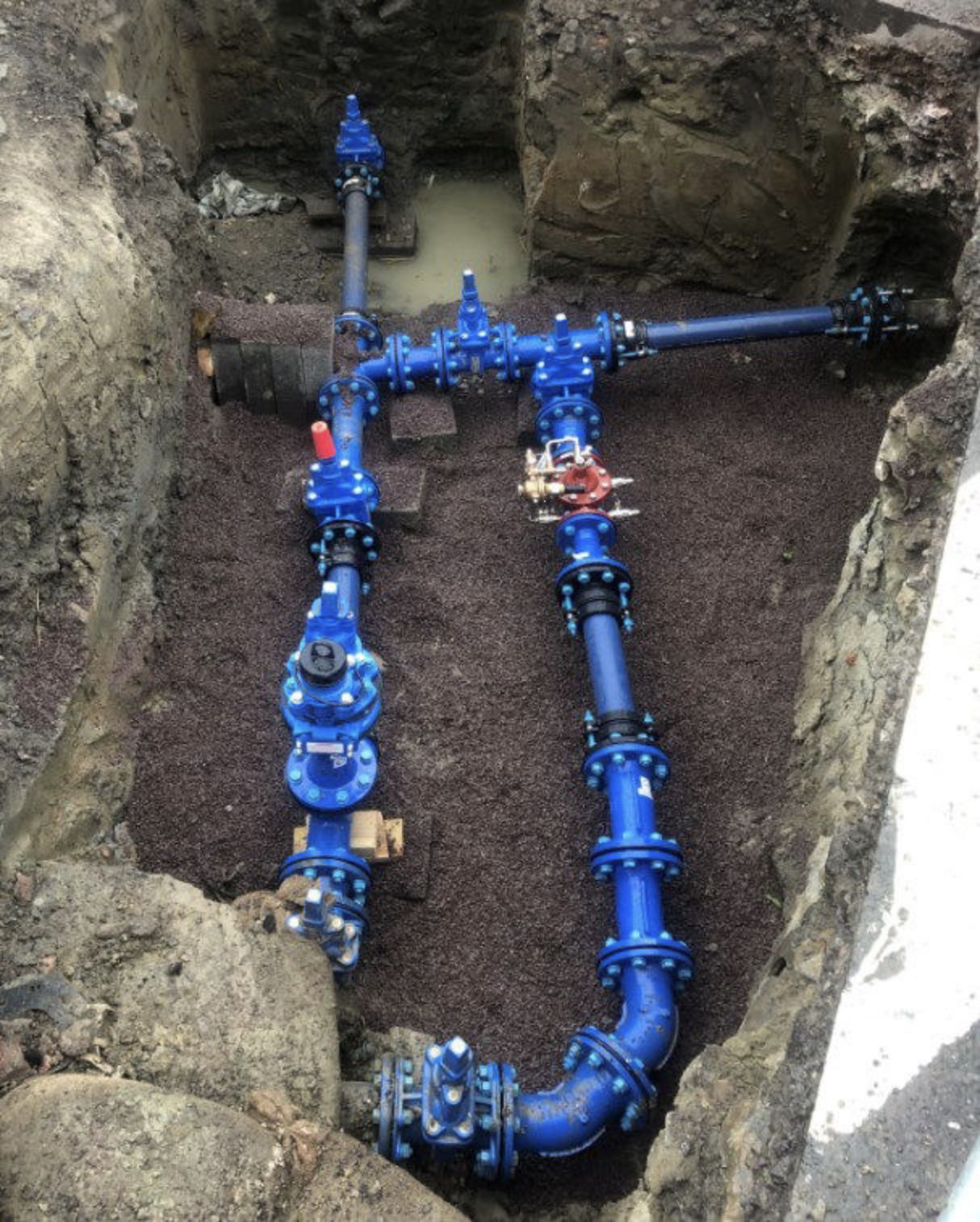
The LCE Trenchless team is highly experienced in both Pipe Bursting and Slip Lining. The Project Management team who oversaw Wraxall Phase 1 have a lifetime of experience in all matters of pipeline construction, bringing in this scheme both ahead of programme and on budget.
The delivery of the scheme was through our specialised directly employed team, enabling us to offer a saving over the alternative of subcontracting, passing on value to Bristol Water.
Paul Nichols Stables: Engaged 3months prior to SOS through ECI. Works scheduled to take place during off peak training periods.
Highways: TM agreed upfront (3m+), closures and diversions routes discussed and agreed.
Local farms: engaged prior to SOS to discuss water usage, delivery routes, tinkering requirements etc
Parish Council: several meetings and discussions with Parish Council both before and during construction to ensure they were aware of works and any changes.
Local Residents: Regular letter drops to keep the village well informed. Including items such as programme, planned works, changes to traffic management etc.
Phase 1 was completed on the 14th June with 220m of existing asset renewed by sliplining and 700m by pipebursting. Joint site walkovers were held bi-weekly with all snags picked up as the scheme progressed.
As-built information was collated and issued to the design team on a regular basis. Positional information was collected using GPS and issued on CAD drawing for easy transfer into scheme drawings.
The contract adopted for this framework is Target cost with pain/gain mechanism. Phase 1 actual costs have all been agreed, and are in-line with Target Cost allowances. The final account position will be agreed on completion of Phase 2 works and once all costs are collated.
Currently forecast out-turn costs indicate marginal gain on cost and programme.
We anticipate final account will be amicably agreed within 6 weeks of completion.
The required Launch/Reception Excavations will be carried out at pre-determined locations. The launch/reception pits will be of varying distances from each other to allow installation in the most efficient manner and will consider factors such as existing utility services and potential to combine the excavation with connections/service connections etc.
For each excavation, area utility plans will be closely studied, identifying any buried apparatus. The immediate vicinity will be visually surveyed to identify possible services routes and drainage systems that run through the proposed work area. The excavation area then scanned using the eCAT4+ & Genny with all findings marked on the ground along the perceived tracked route with spray paint for future reference. The CAT is very limited without the use of the Genny in tracing potential buried services—so make sure genny is used!
A permit to dig will be issued and then the excavation will commence to locate and expose the existing 3” Cast Iron water main. Once the area has been scanned, and deemed safe to excavate (ie no services have been highlighted, and there are no obvious signs of trench lines, old excavations, marker signs, manhole or duct boxes etc.) then an excavator fitted with a TOOTHLESS bucket can remove the surface of the soil. If the excavations are within the highway, the tarmac surface will be cut using a road saw (complete with a water supply to supress any dust created). The operator will wear eye, respiratory and hearing protection whilst using the saw. Vibration exposure must be recorder and monitored when using any item of equipment that can expose the user to hand arm vibration risks. All excavation work will be under the supervision of a competent banksman.
The section of 3” CI Potable water main running through the excavation will be isolated by BW and a certificate of isolation will be issued to the site team confirming the main is safe to work on. The existing water main will be cut using a disc cutter. A small slit will be cut to ensure that there is no pressure within the main. Once satisfied the water main contains no pressure, a section of the pipe can be removed on both the launch and reception pits.
The rig 400g (weighing 560kgs) and bursting rods will be lifted in using the 8t tracked excavator complete with appropriate lifting equipment according to the Lift Plan. All lifting operations will be controlled by a competent slinger/ signaller.
When the bursting rig has been lifted in and levelled up it will be connected to its power source which is hydraulic power pack/generator. The power pack will be situated far enough away from the excavation to ensure exhaust fumes are naturally vented away from the working area and not drawn into the excavation. Inter-connecting bursting rods (weighing 7.5ks each) will then be manually handled and fed into the existing 3” CI diameter main using the rig to push them through the pipe until they reach the launch pit at the other end. The rods must be counted as they are attached so we know when the correct length has been inserted through the pipe. Radio communication must be maintained between the launch pit and the bursting rig operator.
When the rods are through the pipe the expander and splitting head will be attached to the rods in the launch pit and the lead end of the new 90mm PE SDR 17 pipe will be attached to the back of the head (PE pipe previously welded). BEFORE STARTING PULL BACK WE MUST ENSURE THAT NO PERSON STANDS DIRECTLY BEHIND OR TO SIDE OF THE RIG.
The Bursting Rig will be reversed by the operator and the rods pulled back towards the reception pit. In doing so the splitting head and expander breaks and displaces the existing 3” CI diameter pipeline, pulling in the new 90mm diameter PE pipe as it progresses.
It is vital that a radio link between launch and reception pits is maintained throughout the bursting operation until the splitting head, expander and new pipe is exposed in the reception pit. The equipment can then be removed and the pipe connected to the existing pipe/s/v chamber. The Water Main is then commissioned/chlorinated/flushed and prepared for use. (refer to risk assessments for risk ratings)
The required Launch/Reception Excavations will be carried out at pre-determined locations as described on the previous page. The existing main will be drilled and tapped and a ferrule installed to allow controlled access and discharge any redundant water pressure within the isolated section of main. This may also be utilised to drain down the section of main if no other fire hydrants are within the isolation section. Once satisfied that the water main contains no redundant water pressure, a section of the pipe can be removed on both the launch and reception pits following a satisfactory lift assessment have been carried out. The existing water main will be cut using a disc cutter.
A camera survey will be undertaken of the internal of the existing main for the full length of intended slip lining section to confirm suitability and identify potential obstructions that could be removed to allow a successful installation.
Where the work site is of sufficient length that both launch and reception pits can be excavated within same TM arrangement, it is vital that a radio link between launch and reception pits is maintained throughout the operation to ensure safe working practices are adhered to at both ends of the works. The slip lining operation will continue until the new pipe is exposed within the reception pit. The new pipe can then connected to the new connection complexes or pieced into the last section of new main. Should the newly installed section of main need to be installed directly into a live network, temporary test ends will be installed at either end and the commissioning process will commence including the chlorination and sampling to confirm new main is satisfactory clean to allow the connection into the live network.
Whilst working on the pipe and fittings all operatives must practice high levels of hygiene ensuring all pipes are clean and plenty of Chlorus solution (1000mg/l) is sprayed to kill any bacteria that may be present. All operatives working on the pipes must hold the EUSR Water Hygiene Card.
An 8t mechanical excavator fitted with a hydraulic Poly Pipe Pusher attachment will be positioned at the end of the launch pit above the main to be inserted. When the excavator and coil trailer are in position, the perimeter of the slip lining zone will be fenced off to prevent accidental access during the works.
Once the operator and banksman are satisfied that the immediate work zone is secure, the slip lining operation can commence. The excavator will grasp the new HPPE pipe and pull towards the open end of the existing/abandoned main ensuring the tapered lead pipe enters the old main, the pusher attachment will then be released and re-gripped further back to be pulled in again. This action will be repeated until the desired length is installed, care will taken by the operator not to gouge the new HPPE pipe against the existing abandoned main which could result in a pipe failure (burst) once main is pressurised.
A banksman will supervise the operation to ensuring adequate clearance is kept away from the adjacent live water main. Where the required installation length is greater than a coil of pipe, additional 6mtr pipe lengths and/or pipe coils will be butt fused to extend the pipe string to the desired installation length. Once new HPPE pipe has been installed to the desired length, any surplus pipe will be cut off and pipe end capped off to prevent accidental contamination until jointing is carried out.
Should the pipe string stop due to unidentified obstruction, location will be excavated and section of existing/ abandoned main will be cut out to allow slip lining operation to continue. Should area of unidentified obstruction occur outside of works area / traffic management area, slip lining will cease and next slip lining launch pit distance will be re-calculated to allow next pipe string to be installed back to last pipe install location. (Refer to risk assessments for risk ratings)
Holdenhurst WRC
A £30 million investment by Wessex Water to protect Bournemouth's popular beaches
Location: Bournemouth
Project Type: Water Treatment
Client: Wessex Water
Project Duration: 24 months
Contract Value: £14.5m
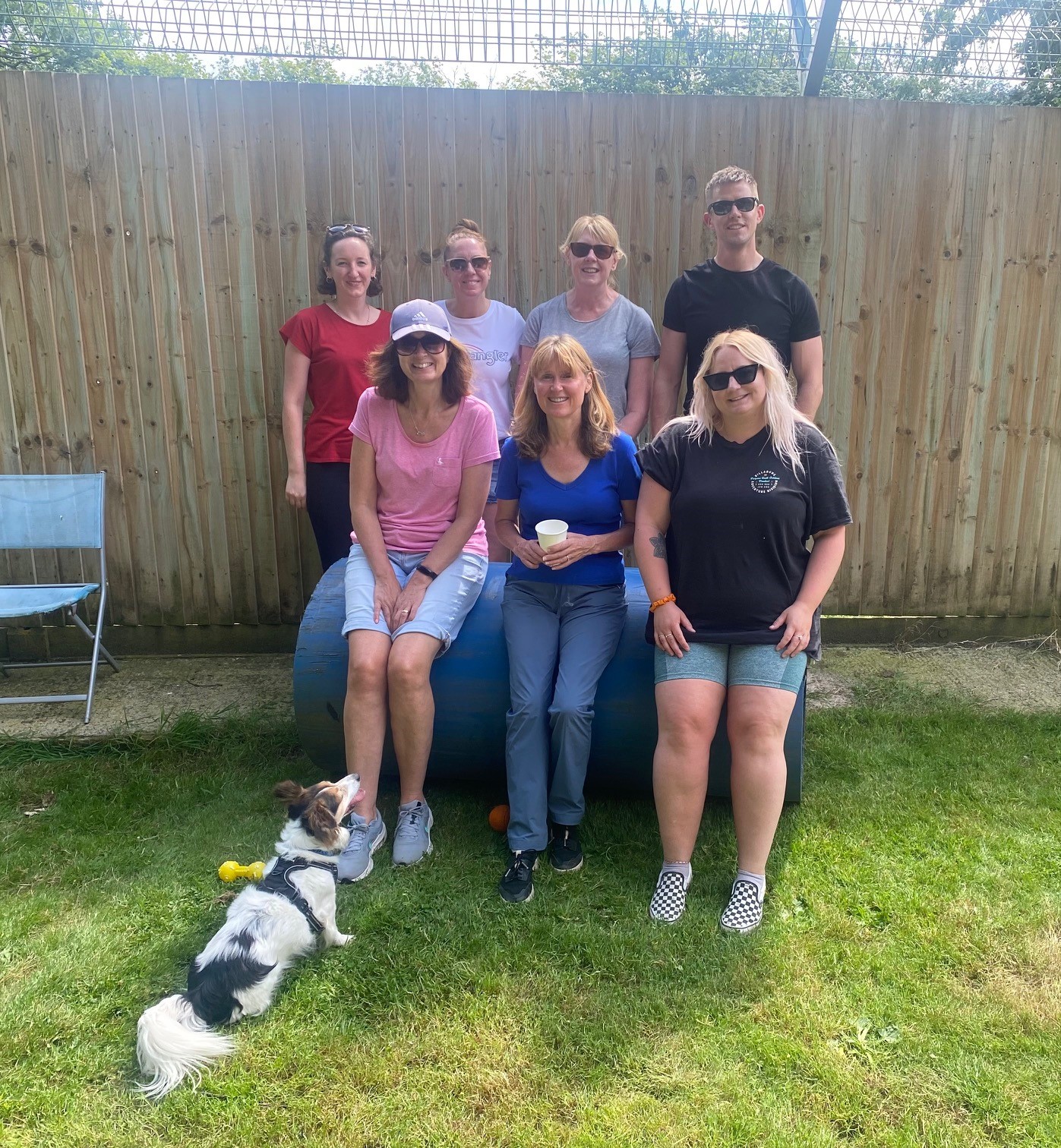
Holly Hedge Animal Sanctuary
Its amazing to see how our time can benefit the sanctuary and its residents.
Location: Holly Hedge Animal Sanctuary
Project Type: ESG
Client: Community Volunteering
Project Duration: 1 day!
Contract Value: £0







